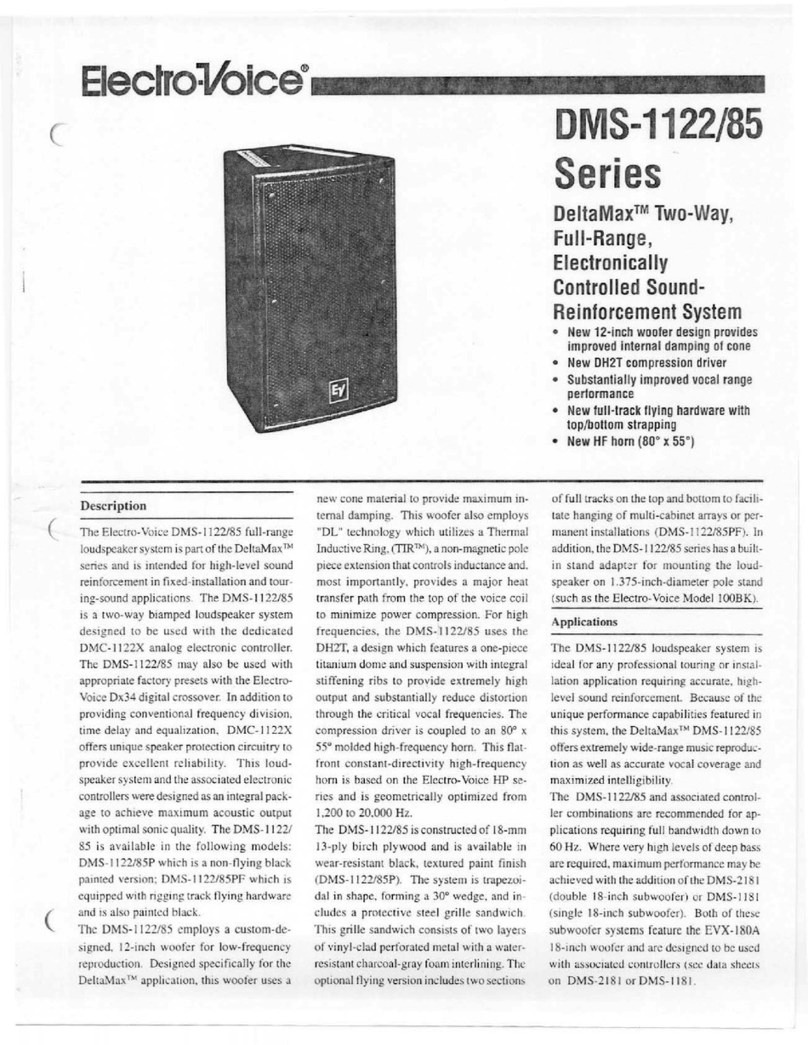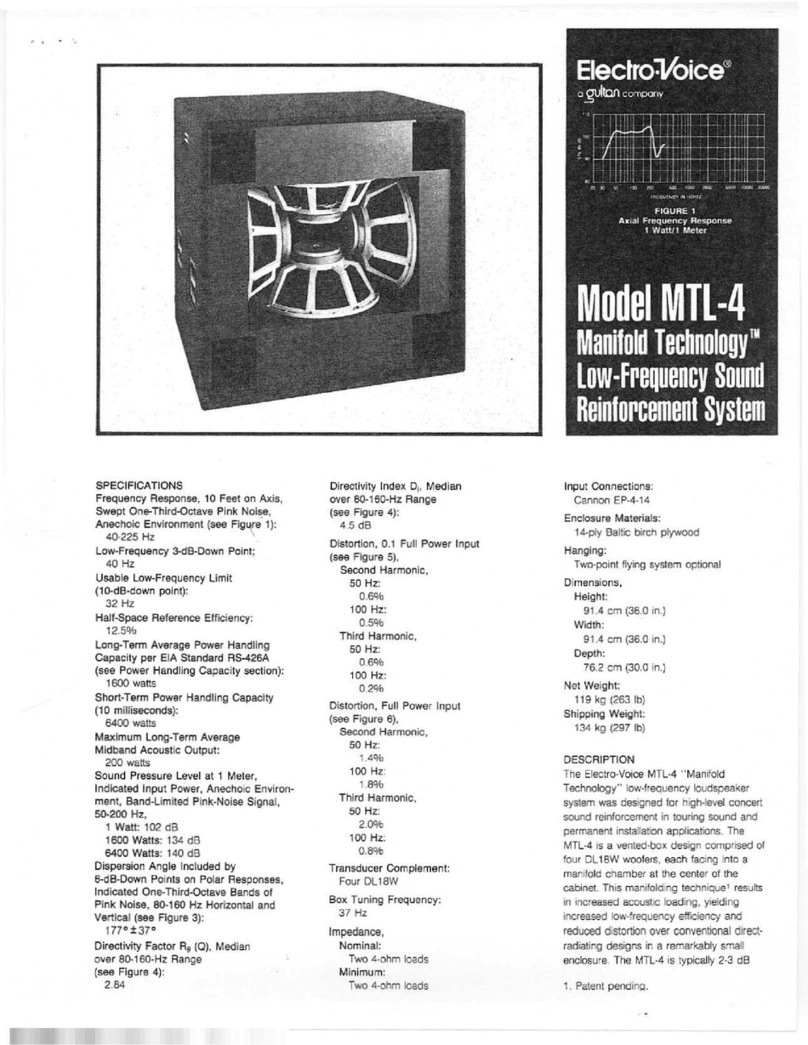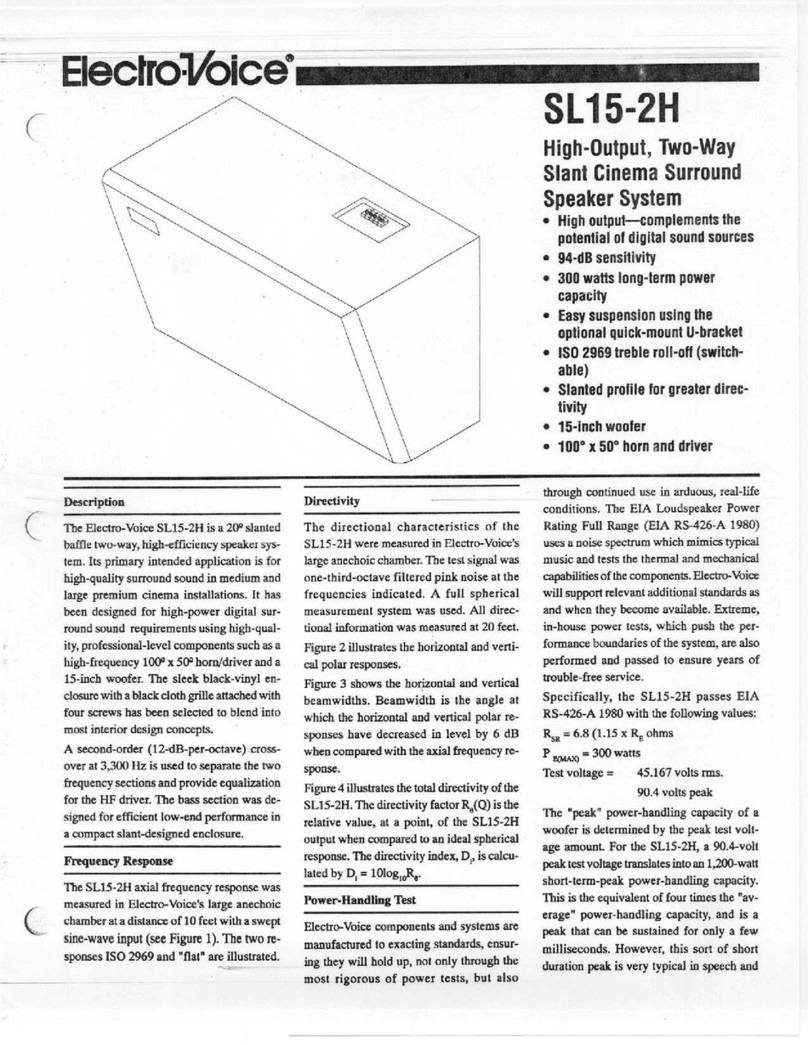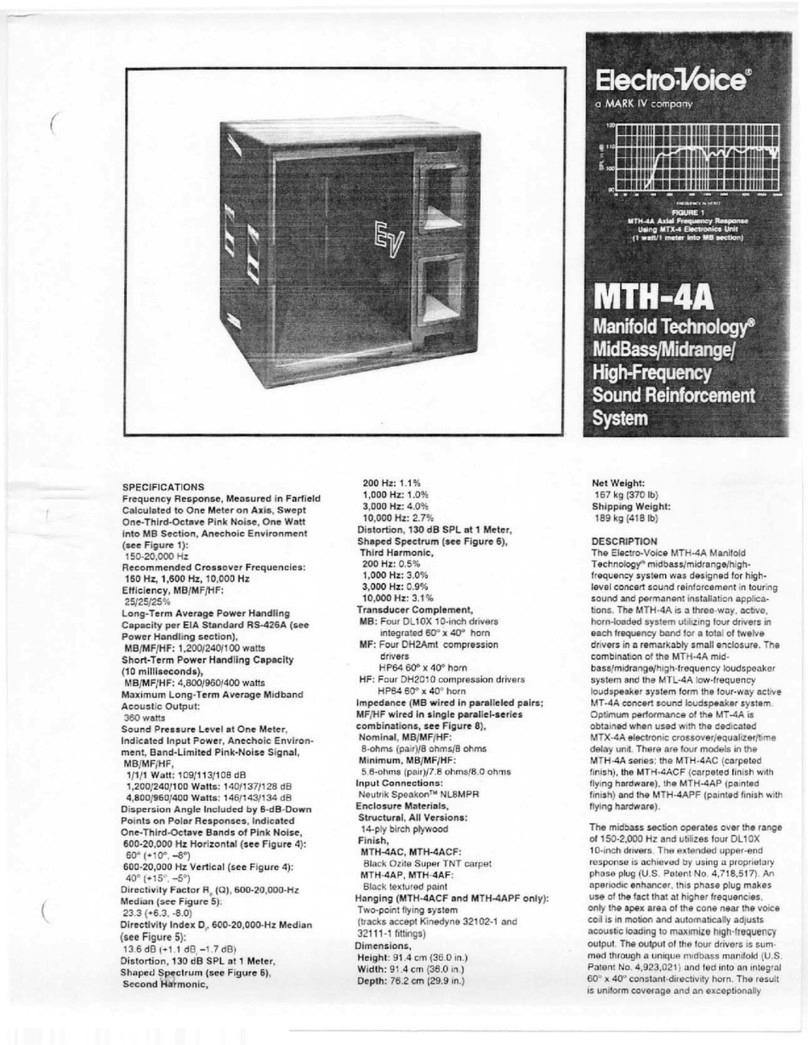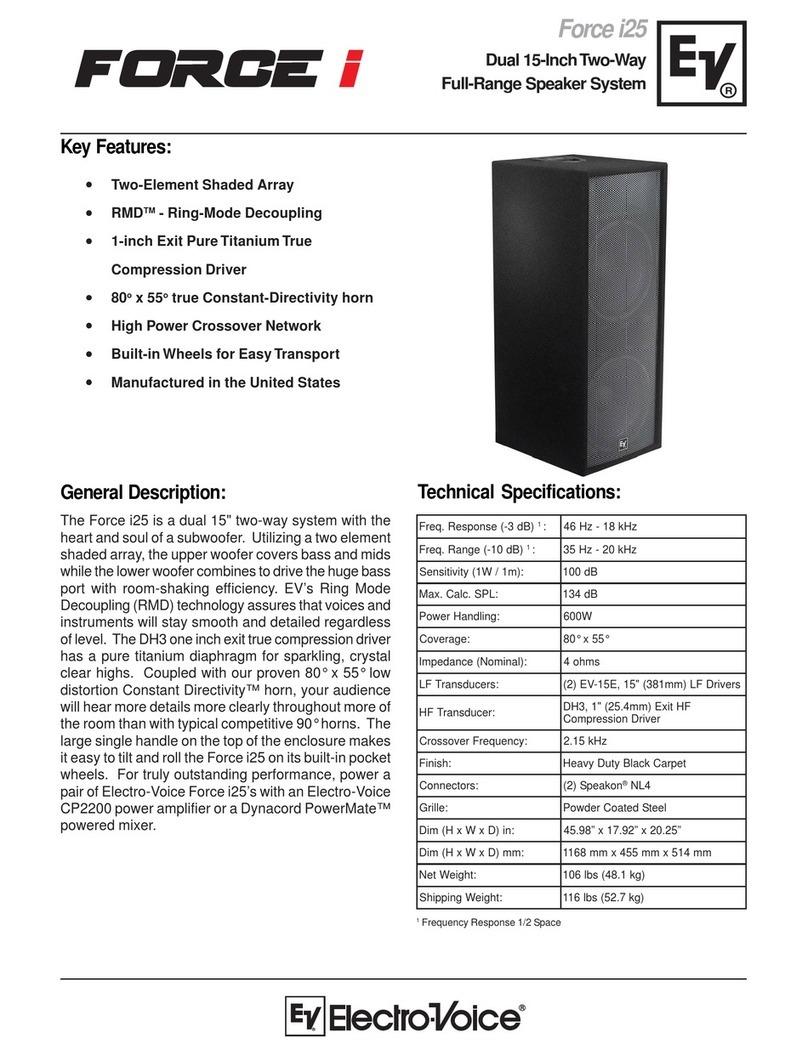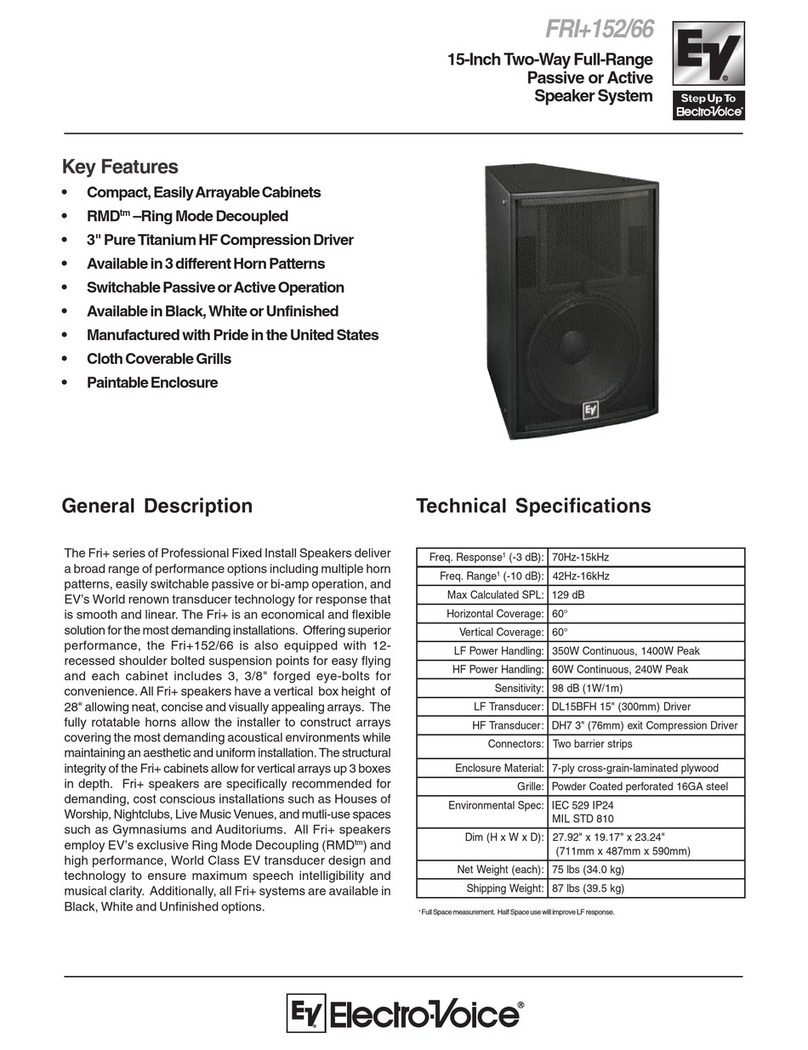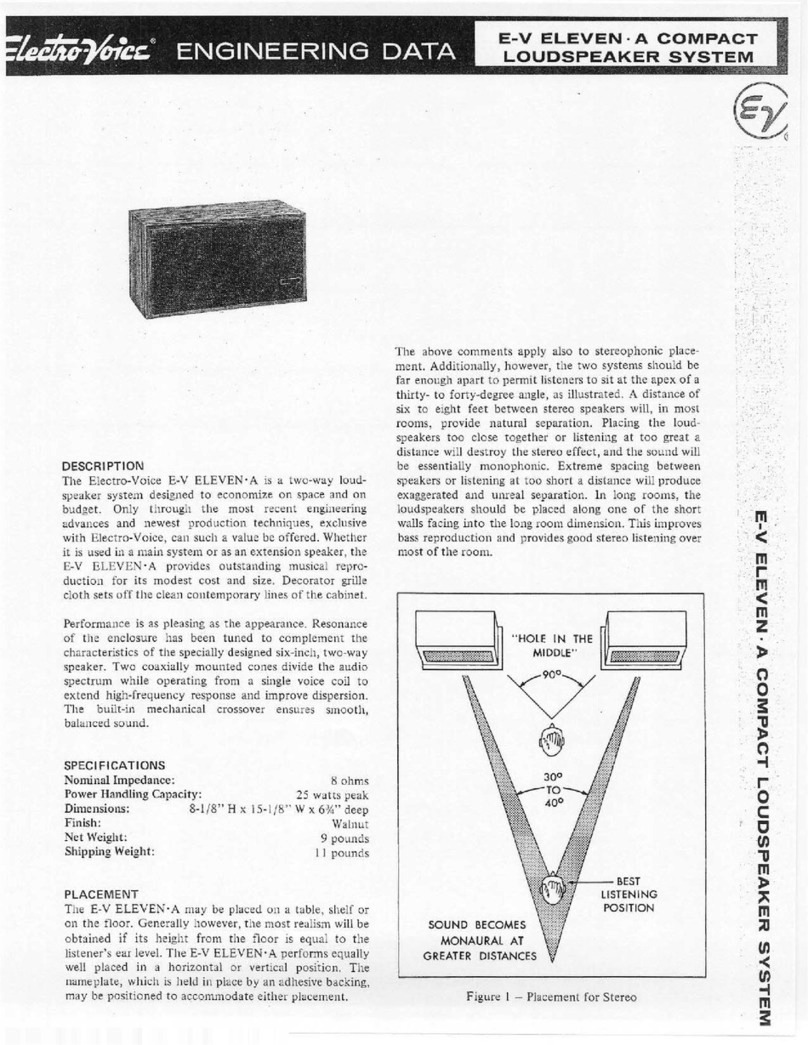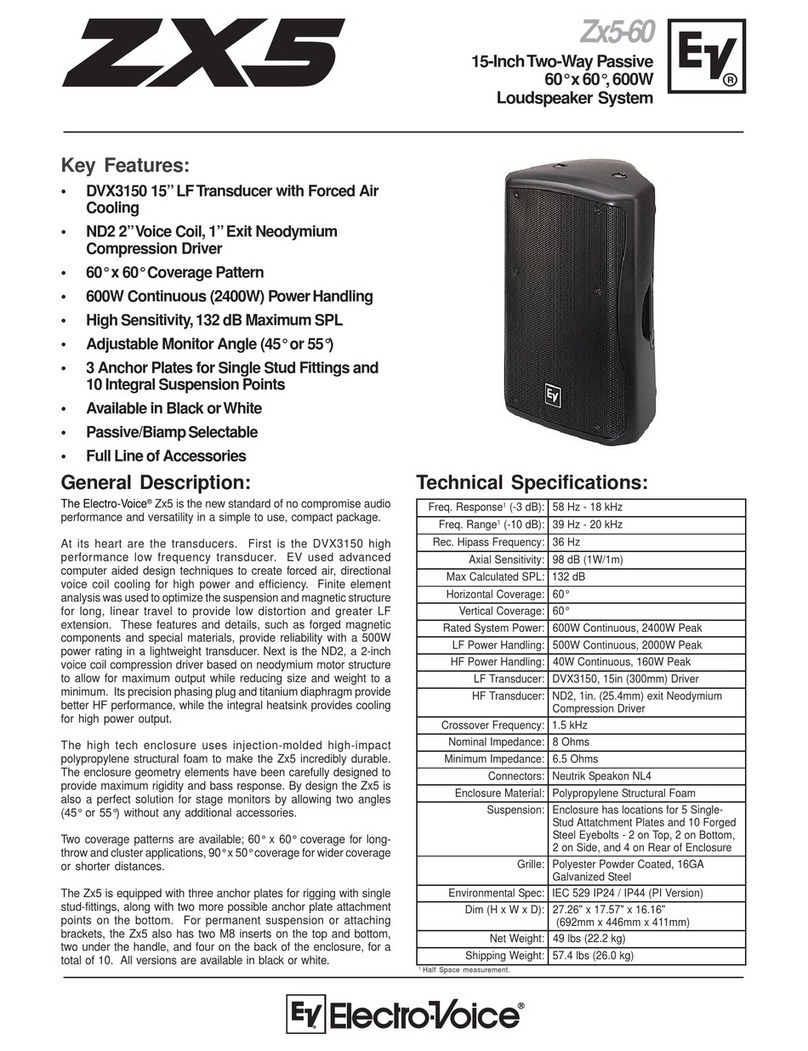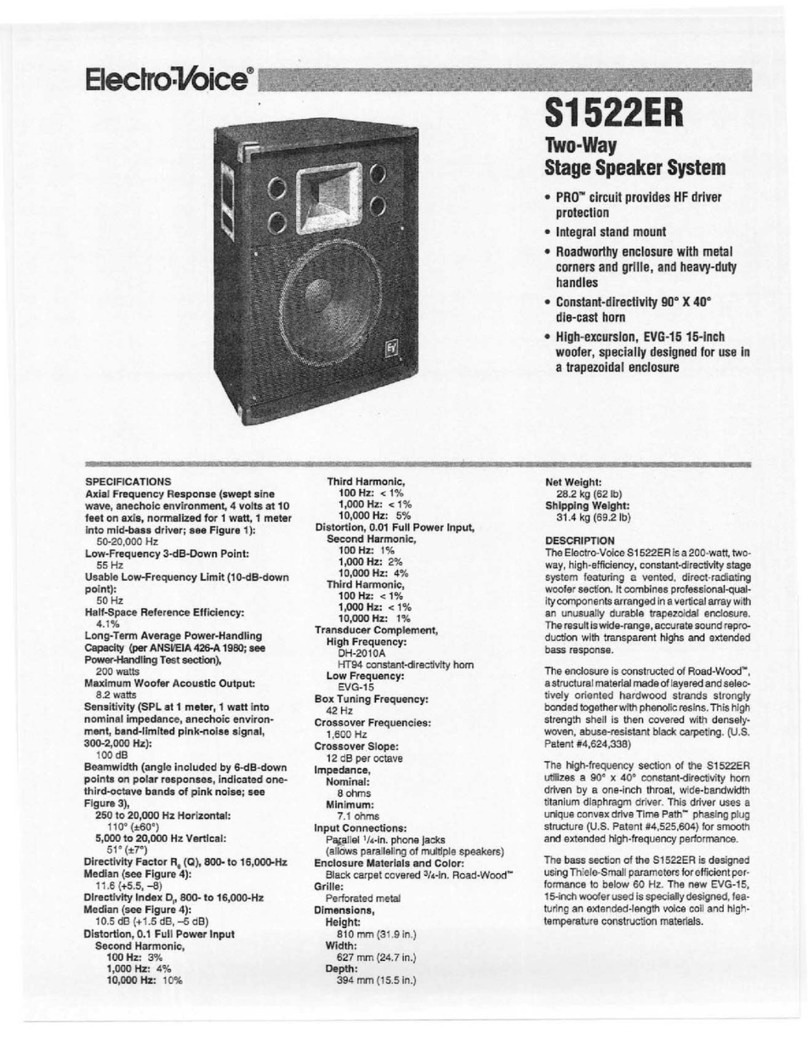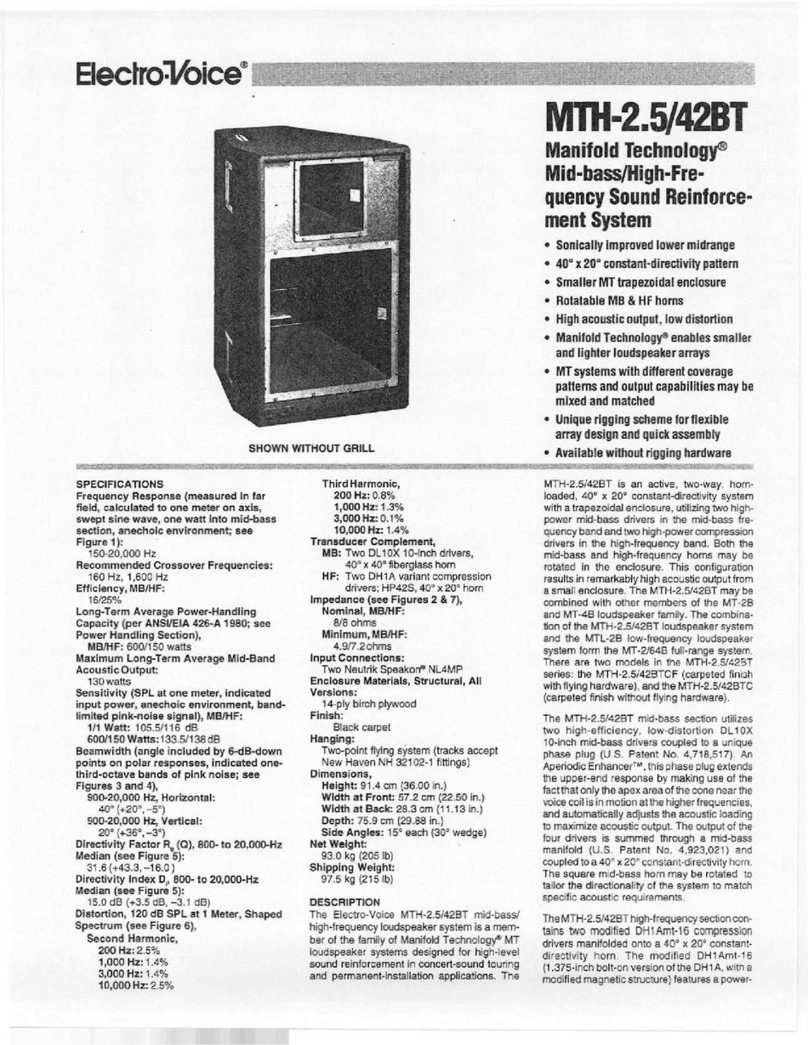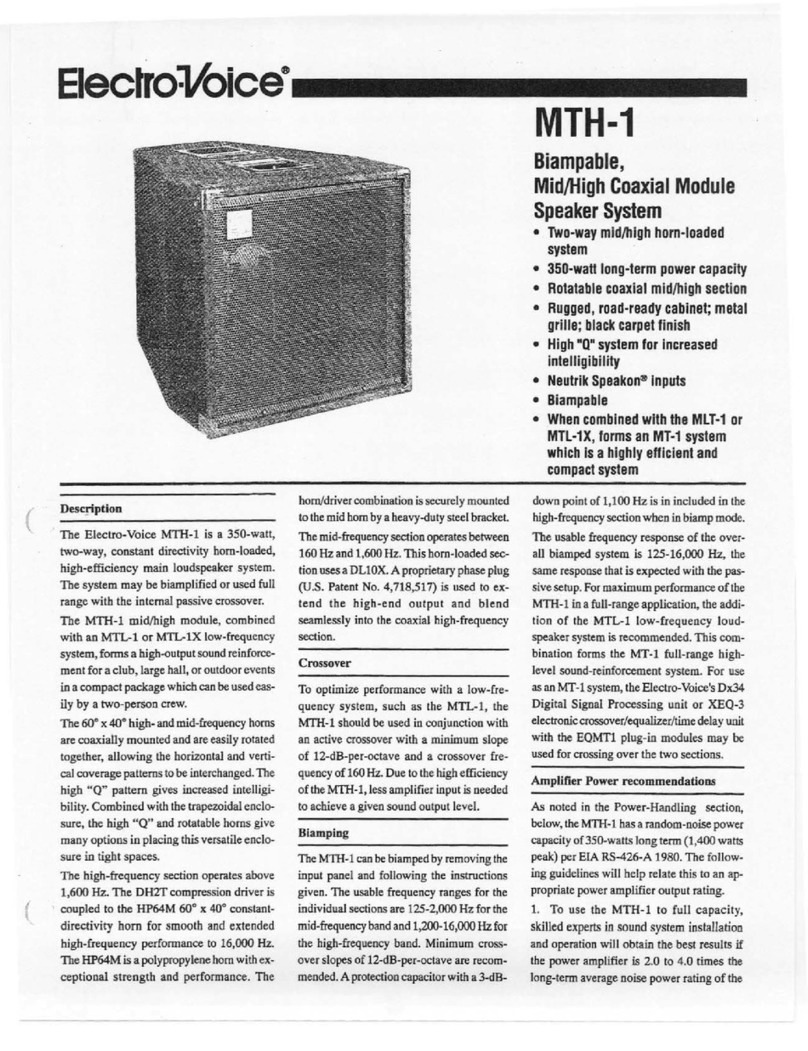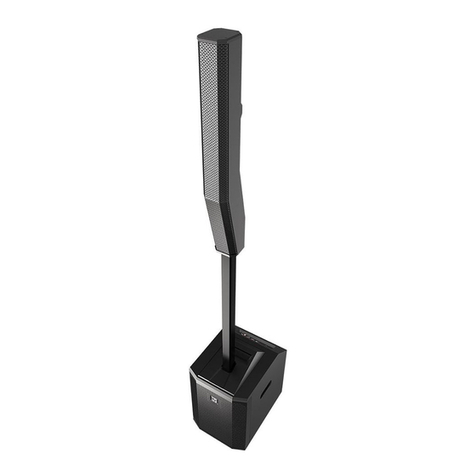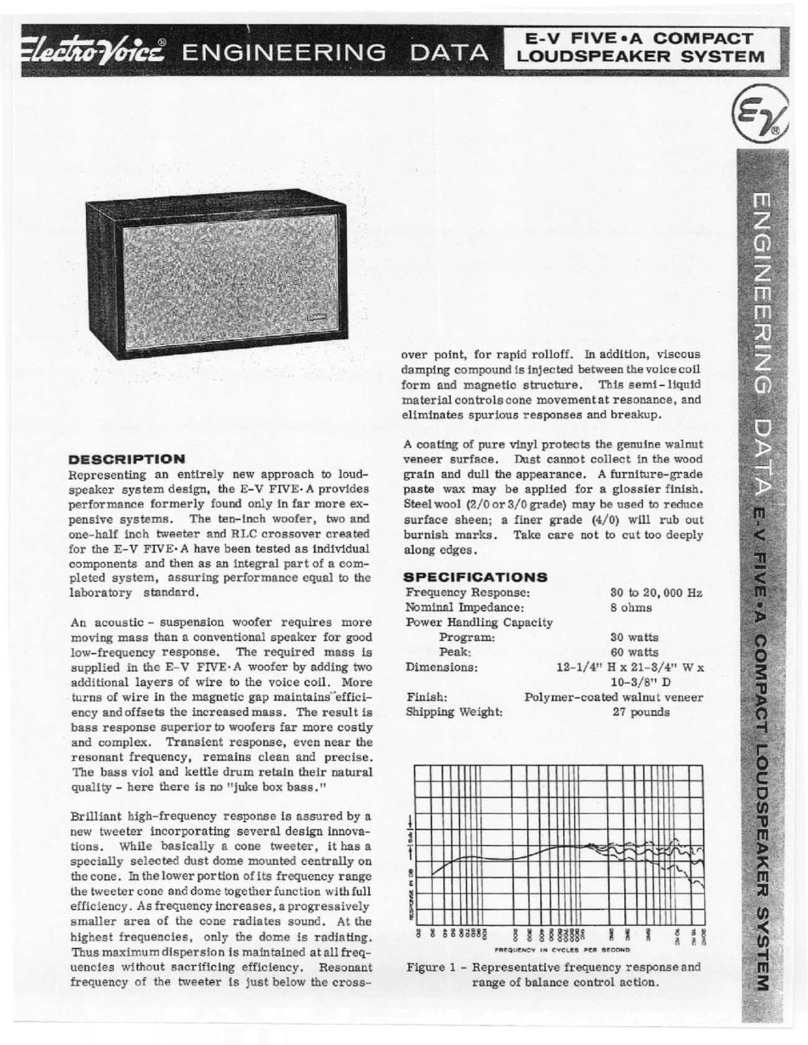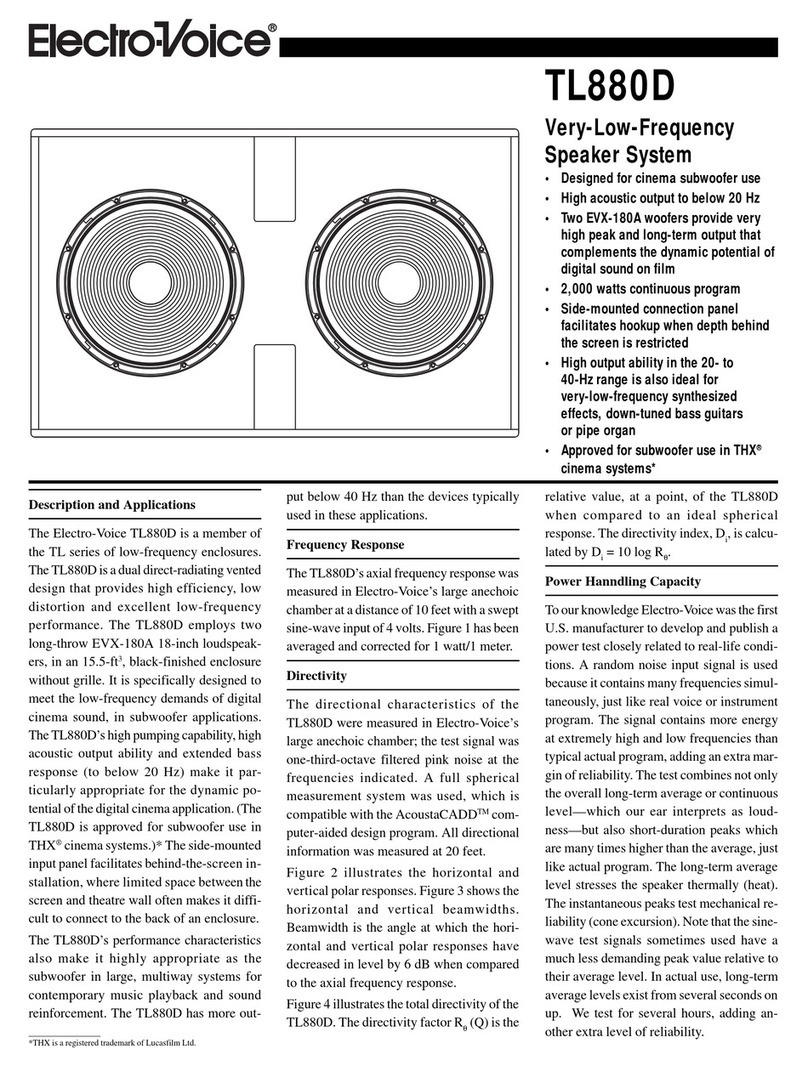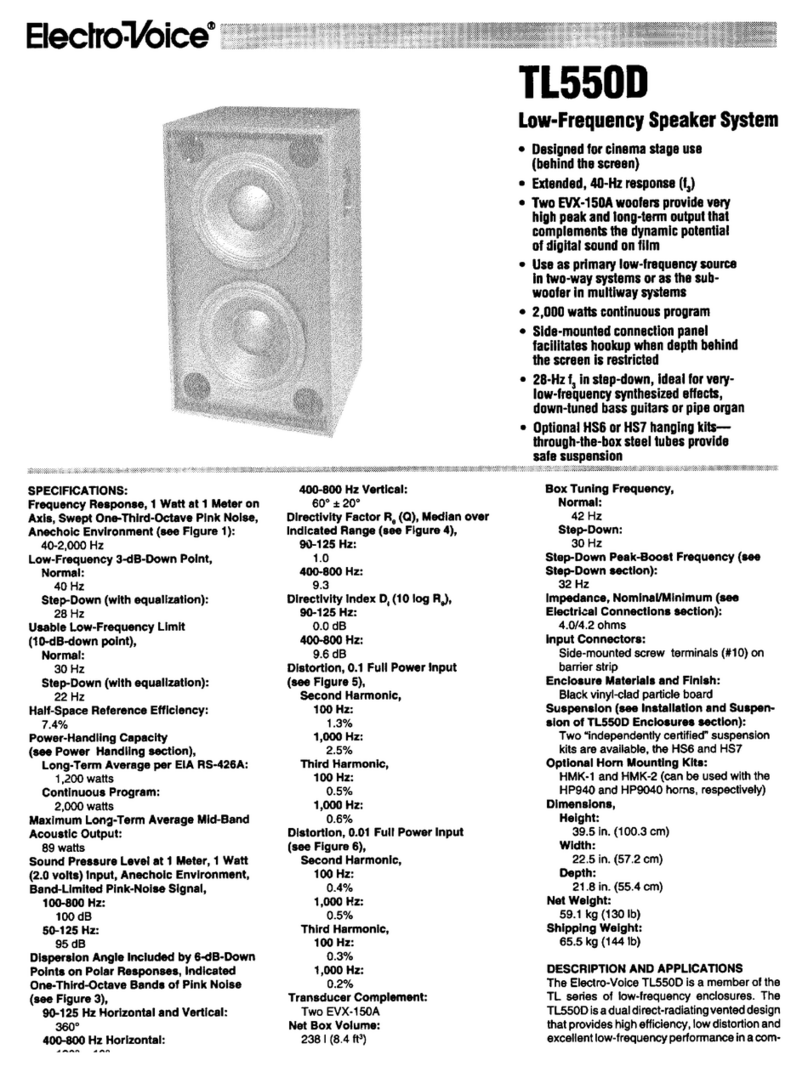
T221M Biampable, Compact, Two-Way Floor Monitor Speaker System
T221M Biampable, Compact, Two-Way Floor Monitor Speaker System
“BIAMP”. The crossover is now in biamp
mode. Carefully replace the crossover and
screws. When the crossover is in biamp
mode, there is an 18-microfarad capacitor
in series with the high-frequency driver for
protection against DC voltages or amplifier
failure. This is not a crossover. It is how-
ever, protection against some forms of am-
plifier failure. An active crossover with a
crossover frequency of 1,600 Hz (1.6 kHz)
with slopes of 12 dB per octave or greater is
required. Whenever possible, a crossover
with 24-dB-per-octave slopes should be
used.
Note: The PROTM circuit is still protecting
the high-frequency driver when the system
is in biamp mode.
Connections
The T221M is equipped with Neutrik
Speakon®NL4MPR connectors. Two con-
nectorsare installed in parallel, one mounted
on each end of the enclosure allowing
multiple T221M’s to be used and “daisy-
chained”together. These NL4FC connectors
are used because they are locking, self-po-
larizing and capable of 30 amps rms con-
tinuously.
Full-range pin arrangements are:
1– = IN, FULL RANGE(–)
1+ = IN, FULL RANGE(+)
2– = Not used
2+ = Not used
Biamp pin arrangements are:
1– = IN, LOW FREQUENCY (–)
1+ = IN, LOW FREQUENCY (+)
2– = IN, HIGH FREQUENCY (–)
2+= IN, HIGH FREQUENCY(+)
If you experience any difficulty in obtain-
ingcables, connectors or wiringaccessories,
the following companies can be contacted:
Neutrik USA, Inc.
1600 Malone Street
Millville, NJ 08332
Pro Co Sound, Inc.
135 E. Kalamazoo Avenue
Kalamazoo, MI 49007
WhirlwindMusicDistributors,Inc.
P.O. Box 1075
Rochester, NY 14603
Power-Handling Capacity
To our knowledge, Electro-Voice was the
first U.S. manufacturer to develop and pub-
lish a power test closely related to real-life
conditions. First, we use a random-noise in-
put signal because it contains many frequen-
cies simultaneously, just like real voice or
instrument program. Second, our signal con-
tains more energy at extremely high and low
frequenciesthantypicalactual program, add-
ing an extra measure of reliability. Third, the
test signal includes not only the overall
“long-termaverage”or “continuous” level—
which our ears interpret as loudness—but
also short-duration peaks which are many
times higher than the average, just like ac-
tual program. The long-term average level
stresses the speaker thermally (heat). The
instantaneouspeaks test mechanical reliabil-
ity (cone and diaphragm excursion). Note
that the sine-wave test signals sometimes
usedhave a much less demanding peak value
relative to their average level. In actual use,
long-term average levels exist from several
seconds on up, but we apply the long-term
average for several hours, adding another
extra measure of reliability.
Specifically, the T221M is designed to with-
stand the power test described in EIA Stan-
dard RS-426A. The EIA test spectrum is
applied for eight hours. To obtain the spec-
trum, the output of a white-noise generator
(white noise is a particular type of random
noisewithequalenergyper bandwidth in Hz)
is fed to a shaping filter with 6-dB-per-oc-
tave slopes below 40 Hz and above 318 Hz.
When measured with an analyzer having the
usual constant-percentage bandwidth (one-
third octave), this shaping filter produces
a spectrum whose 3-dB-down points are
at 100 Hz and 1,200 Hz with a 3-dB-per-
octave slope above 1,200 Hz. This shaped
signal is sent to the power amplifier with the
continuous power set at 400 watts into the
5.98-ohm EIA equivalent impedance
(48.9 volts true rms). Amplifier clipping
sets instantaneous peaks at 6 dB above the
continuous power, or 1,600-watts peak
(97.8 volts peak). This procedure provides a
rigorous test of both thermal and mechani-
cal failure modes.
Architects' and Engineers'
Specifications
The loudspeaker system shall be a two-way,
full-range design consisting of a 305-mm
(12-inch) woofer in a vented enclosure, a
high-frequencycompression driver mounted
on a 80° x 55° constant-directivity horn, and
apassivecrossover/equalizernetwork,which
may be bypassed for use with an external
low-level active dividing network with a
corner frequency of 1,600 Hz. The loud-
speaker shall meet the following perfor-
mance criteria: frequency response of
100-16,000 Hz, –3 dB; full-range power
handling of 400 watts long term and 1,600-
watts short term with a shaped random-noise
input per EIA Standard RS-426A; low-fre-
quency power handling below 1,600 Hz in
the biamp mode of 400-wattslong term and
1,600-watts short term with a shaped ran-
dom-noise input per EIA Standard RS-426A;
high-frequency power handling above
1,600 Hz in the biamp mode of 60-watts
long term and 240-watts short term with a
shapedrandom-noiseinputper EIA Standard
RS-426A;sensitivity of101dB SPLat1 meter
with a 1-watt, 300- to 3,000-Hz pink-noise
input; 6-dB-down horizontal coverage angle
of 55° ±5° in the 5,000- to 16,000-Hz range;
6-dB-down vertical coverage angle of 80°
±5° in the 5,000- to 16,000-Hz range; cross-
over frequency of 2,600 Hz (electrical);
nominal impedance of 8 ohms; and mini-
mum impedance of 6.7 ohms. Input con-
nections shall be two paralleled Neutrik
Speakon®NL4MPR connectors for full-
range and biamp operation. The enclosure
shall be constructed of curved plywood,
covered with black textured paint and fit-
ted with a 16-gauge black steel grille, rub-
ber feet and a recessed carrying handle. Di-
mensions shall be 371 mm (14.62 in.) high x
594 mm (23.4 in.) wide x 406 mm (16.0 in.)
deep. Net weight shall be 22.3 kg (49 lb).
Theloudspeaker system shall bethe Electro-
Voice T221M.

